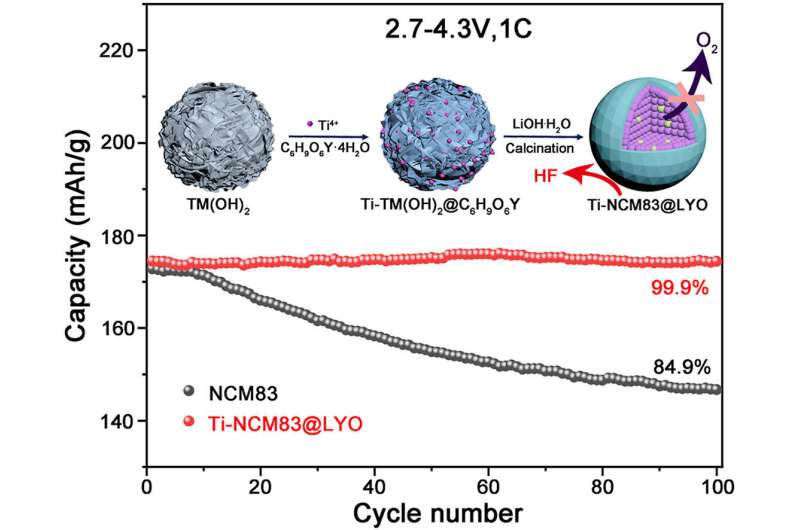This article has been reviewed according to Science X's editorial process and policies. Editors have highlighted the following attributes while ensuring the content's credibility:
fact-checked
proofread
Team stabilizes nickel-rich cathodes for use in long-life lithium-ion batteries

Nickel-rich layered cathodes are promising candidates for the next-generation high-energy lithium-ion batteries because of their high energy density and competitive cost. However, with long-term operation, these cathodes suffer from rapid capacity fading. A research team including Hanwen Zheng, Zhihong Wang, Ling Chen, Hao Jiang and Chunzhong Li from East China University of Science and Technology has created a simple, one-step dual-modification strategy to restrain these side reactions that occur and enhance the cathode's structural stability, to meet the commercial requirements of nickel-rich cathodes.
The team's findings are published in the journal Particuology on January 5, 2023.
Lithium-ion batteries with high energy density are urgently needed to meet the increased demand of electronic devices and vehicles. At this point in time, the use of lithium-ion batteries is mainly constrained by the limited specific capacity of their cathode material. Nickel-rich layered cathodes always suffer from rapid capacity fading because of the structural and interfacial instability that occurs with long-term operation.
In an effort to solve these problems, scientists have used tactics such as surface coating and elements doping with the cathode materials. But single modification processes cannot solve the structural and interfacial instability at the same time. The single element doping strategy fails to prevent the cathode/electrolyte reaction, while the coating materials typically exhibit poor lithium-ion conductivity. This issue increases the interfacial impedance and decreases the specific capacity.
A high-efficiency dual-modification was needed in order to achieve advanced nickel-rich oxides with high specific capacity and long-cycling life. The research team's work provides a simple, one-step dual-modification strategy that limits the interfacial parasitic side reactions and enhances the structural stability, while meeting the commercial requirements of nickel-rich cathodes. Their co-modified cathode displays superior electrochemical performance with excellent long-term cycling stability.
The team synthesized the titanium-doped and lithium yttrium dioxide-coated (LiYO2) nickel-rich layered cathode using a simple one-step sintering strategy. The sintering process uses heat and pressure to form a solid mass of material. This strategy developed by the team significantly restrains the interfacial parasitic side reactions, while at the same time enhancing the cathode's structural stability.
The team used X-ray diffraction to analyze the crystallographic structure of their cathodes. They researched the morphologies of the cathodes using scanning electron microscopy. Transmission electron microscopy was applied to characterize the hyperfine structure and elements distribution, and they used X-ray photoelectron spectra to study the surface element compositions and valence state. Their results showed that their dual-modified cathode material had an improved capacity retention of 96.3% after 100 cycles and 86.8% after 500 cycles, much higher than the unmodified cathode materials.
The LiYO2 coating layer acting as a physical barrier significantly restrains the interfacial parasitic side reactions and the dissolution of transition metal ions. This enhances the cathode–electrolyte interface stability. The robust titanium-oxygen bonds effectively stabilize the lattice oxygen as well as alleviate the lithium/nickel disorder. The team's dual-modified strategy results in a cathode material with faster lithium-ion diffusion rate and outstanding electrochemical stability.
Looking ahead the team hopes to develop their strategy for large-scale production. "In the next step, we would like to apply this dual modification strategy to industrial large-scale production, taking both cathode materials with stable interface/crystal structure and excellent electrochemical performance," said Hao Jiang, a professor at East China University of Science and Technology. At the same time, the team will explore the consistency after amplification to ensure the uniform doping and coating effect. "Moreover, the stability under extremely harsh conditions will be studied to ensure the safety of the material and facilitate its commercial application," said Jiang.
More information: Hanwen Zheng et al, Integrating trace Ti-doping and LiYO2-coating to stabilize Ni-rich cathodes for lithium-ion batteries, Particuology (2023). DOI: 10.1016/j.partic.2022.12.003. www.sciencedirect.com/science/ … ii/S1674200122002759


















